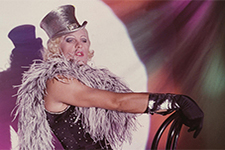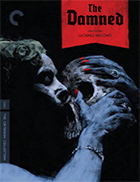The Damned (La caduta degli dei)
|  A far cry from the director’s neorealist roots, The Damned (La caduta degli dei) is Luchino Visconti going for broke. An extraordinary epic of high camp that offers an allegorical depiction of Germany’s fall to the Third Reich as seen through the twisted downfall of an aging steel dynasty, The Damned throws history beneath an onslaught of Freudian pathology, sexual perversity, soap opera theatrics, and Sirkian lighting. Nearly thirty years after Visconti raised the ire of Benito Mussolini’s Fascist government with Ossessione (1943), a loose reworking of James M. Cain’s The Postman Always Rings Twice and a precursor to the neorealist movement that he would embody most thoroughly in La Terra Trema (1948), Visconti clearly recognized that changing cinematic mores had opened the door for something like The Damned, and he didn’t hold back. The result is a film that is both deeply troubling and absolutely hysterical—sometimes at the same time. The opening of The Damned tells you all you need to know. Set against shots of a hellish inferno of smoke and fire that is quickly revealed to be the inner workings of a steel plant, the black letters of the opening credits rush at us with feverish intensity while aggressive, bombastic musical score by Maurice Jarre (a recent Oscar winner for both Lawrence of Arabia and Doctor Zhivago) rattles the speakers. The imagery is dashed and shaky, a far cry from the elegant crane shots that accompany the opening credits of Visconti’s The Leopard (1963) or the long take that moves in on an opera at the beginning of Senso (1954). These handheld, documentary-like closeups of belching smoke and fire feel off-handed and cheap, as if Visconti is taking a dive into low-budget exploitation fare. But then, as soon as the credits end, we are back into familiar territory as we watch the setting of a lavish dinner party by uniformed servants. We are back in the world of the storied aristocracy, a common trope in Visconti’s post-neorealist films, and in that juxtaposition he foreshadows (or warns us about) what is to come, namely a radically shifting terrain that mixes serious drama with high camp, historical realism with ahistorical fantasy, verisimilitude with visual operatics. The film focuses on the von Essenbecks, “an archetypal family of large steel industrialists,” according to Visconti, and one that he argued was not explicitly based on the real-life Krupp or Thyssen families, although most evidence suggests otherwise. The lengthy opening scenes depict the birthday celebration of the von Essenbeck patriarch, Baron Joachim von Essenbeck (Albrecht Schoenhals), which happens to coincide with the night that the Reichstag was burned, a pivotal event in the foundation of Nazi Germany. All of the political tensions are present at the table, particularly in the presence of Baron Konstantin von Essenbeck (Reinhard Kolldehoff), Joachim’s nephew who has already gone full Nazi and preaches the tents of National Socialism much to the patriarch’s dismay. He is further dismayed by the flamboyant pre-dinner performance given by his grandson, Martin (Helmut Berger), who proceeds to scandalize the otherwise staid night with a drag performance as Marlene Dietrich in The Blue Angel (1930). Martin is the youngest son of Joachim’s widowed daughter-in-law, Sophie (Ingrid Thulin), who is secretly involved with Friedrich Bruckmann (Dirk Bogarde), who works as an executive for the von Essenbeck’s steelworks company. That night Joachim is murdered by Friedrich, which puts the future of the steelworks into the hands of both Konstantin, who is a member of the Nazi SA, and Martin, thus throwing the family in turmoil. The murder is blamed on Herbert Thallman (Umberto Orsini) because he is anti-Nazi, which forces his to run for his life, leaving behind is wife, Eliszabeth (Charlotte Rampling), and their children. After that, the film draws us through a protracted power struggle, with subsequent interfamilial murders and all kinds of perversions involving Martin, whose already aberrant inclinations make him a perfect fit for the ascending horrors of Nazism. With his slicked hair, painted-on eyebrows, and leering stare, Martin is sickness incarnate, which plays out in both his pedophilic abuse of his young nieces and a young Jewish girl, and later the literal rape of his own mother. The drag performance that opens the film is a mild precursor of the perversities to come, which Visconti curiously and troublingly conflates. That is, for Visconti, who was himself gay and romantically involved with Helmut Berger at the time, homosexuality, bisexuality, cross-dressing, pedophilia, and incest are all relatively equal markers of human debasement, which makes The Damned a strangely reactionary and regressive work, at least in terms of its sexual politics. At the same time, it is entirely possible that Visconti was simply toying with his own demons, throwing them all up on the screen and mixing them with others, both real and imaginary (the myth of rampant Nazi sexual perversion fuels much of The Damned, just as it did the entire cottage industry of Nazisploitation films that followed it and Liliana Cavani’s controversial 1974 drama The Night Porter). This is perhaps best embodied in the film’s most notorious sequence: the dramatization of the “Night of the Long Knives,” when the Nazi SS essentially massacred a majority of the Nazi SA. The SA, or “brownshirts,” had initially helped Hitler in his rise to power, but had since fallen out of favor and been replaced by the SS “blackshirts.” Visconti stages the event as an elaborate gay orgy, with Nazi soldiers getting progressively drunker at a weekend bender in the Bavarian town of Bad Wiessee. As the night wears on, clothes start coming off and men start dressing in drag and dancing and parading and then paring off for the night, at which point the SS arrive in the early hours of the morning with machine guns ready to unload. The aftermath of the sexual antics are bloody, as the SA, many of them still half-naked and adorned in women’s black lingerie, are gunned down by the dozens both inside and outside the hotel. It is a brutal and graphic sequence that, along with Martin’s rape of Sophie, is most likely the cause of the film’s being rated X by the MPAA when it was released in the U.S. And, while Konstantin is one of the victims, the “Night of Long Knives” is otherwise a stand-alone sequence, one that has little relation to the melodramatic antics of the von Essenbecks and therefore has little consequence for the film as a whole except to grind it to a halt so we can observe the sexual debauchery and subsequent slaughter. The graphic mix of sex and violence is perhaps meant to encapsulate everything that was sick and evil about the Nazis, but it feels more like Visconti reveling in his own audaciousness, a literal exploitation of the new screen freedoms that too many critics at the time mistook for artistic daring. Visconti, who was himself the offspring of a Milanese aristocratic family (his mother, although not from aristocracy, was from an Italian industrialist family), knows the terrain of the von Essenbecks well, and The Damned is at its best when it is dramatizing the subtle internal struggles of the collapsing family, putting into stark relief how power shifts, wrenched from one hand to another. Visconti gives the characters’ moral rot flamboyant visual treatment; the cinematography by Pasqualino De Santis, who won an Oscar that year for Franco Zefferelli’s Romeo and Juliet (1969), and Armando Nannuzzi, who worked again with Visconti on Ludwig (1973), emphasizes both darkness and garish color. There is an obvious and direct link between the family’s descent and the ascent of National Socialism, with the latter eventually swallowing the former. The Damned depicts in microcosm how Nazism took over using both seduction and force, which we see embodied in the film’s explicit sex and violence, absorbing the power once wielded by the large industrialist families and making it their own. Power, like matter, is neither created nor destroyed, but rather changes form. It is too bad, then, that is hard to tell whether Visconti is more fascinated or horrified by his characters’ antics, which leaves us wallowing in a sea of depravity without a sense of direction. It is all horror, the horror, which we already knew.
Copyright © 2021 James Kendrick Thoughts? E-mail James Kendrick All images copyright © The Criterion Collection | |||||||||||||||||||||||||||||
Overall Rating: 
 (2)
(2)


